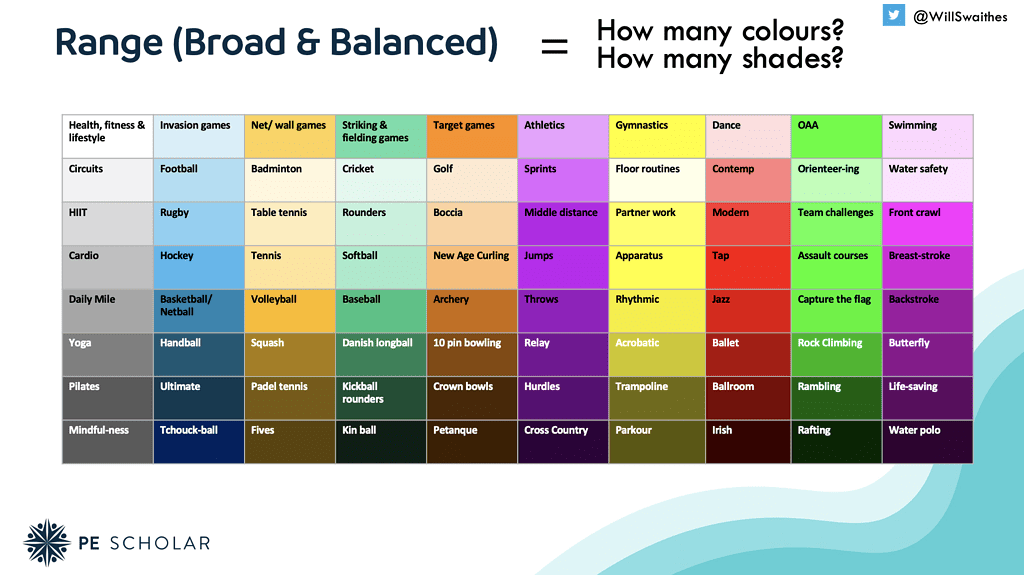
Same, same but different
Taking a critical look at physical education, I am sometimes left wondering if it offers much more than a mere taster carousel of sports and physical activities? I can see that some students enjoy that, typically the ones who already have had exposure to a variety of activities and movement forms beyond school. For those individuals it is thanks to their parents, their local community clubs, their previous schooling or simple play opportunities in their neighbourhood but for every one of those students there appears to be another five who have not had such rich previous exposure.
I can also see why PE teachers may think that a way to prevent boredom or capture refreshed interest could be by mixing up the activities, as such we have seen a drastic increase in schools offering activities like Handball, Tchoukball, Ultimate Frisbee, American Football and Lacrosse to name just a few. Whilst I love these games and can certainly see value in them, I am left wondering if we are doing much more than providing more of the same but with an increasing variety of rules and conventions for students to wrestle with. Is the outcome of that an increase in enjoyment by more of the class or a sense of confusion and a feeling of being ‘no good at sports’? In this blog we take a closer look at how we classify PE activities and how this can ultimately improve our curriculum and extra curricular PE and School Sport offer.
Broad and balanced
When discussing curriculum intent with practitioners from a whole host of different settings and levels of experience, from Initial Teacher Training (ITT) through to Heads of PE who have 30+ years in the game, the vast majority recount the need for PE to be inclusive and provide a diverse mix of opportunities. They typically use the phrase ‘broad and balanced’ or perhaps Ofsted’s current terminology of ‘rich and varied‘ but the take-home message and underlying belief is the same; if we can expose children to a variety of sports and physical activities then we will help them form active habits for life.
For a long time now, most school systems around the world have a curriculum dominated by traditional sports and use the following categories to describe these:
- Invasion Games – separated out into handball (e.g. Basketball), footballl (e.g. Soccer) and stickball (e.g. Hockey) varieties.
- Net/ Wall Games – for example Tennis or Badminton and Squash
- Striking and Fielding Games – for example Rounders or Cricket
- Target Games – for example Archery or Golf
Balancing PE Activities
For quite a while now when delivering CPD or speaking at conferences I have challenged PE leaders to consider their balance of colours and shades using the following rainbow paint chart:
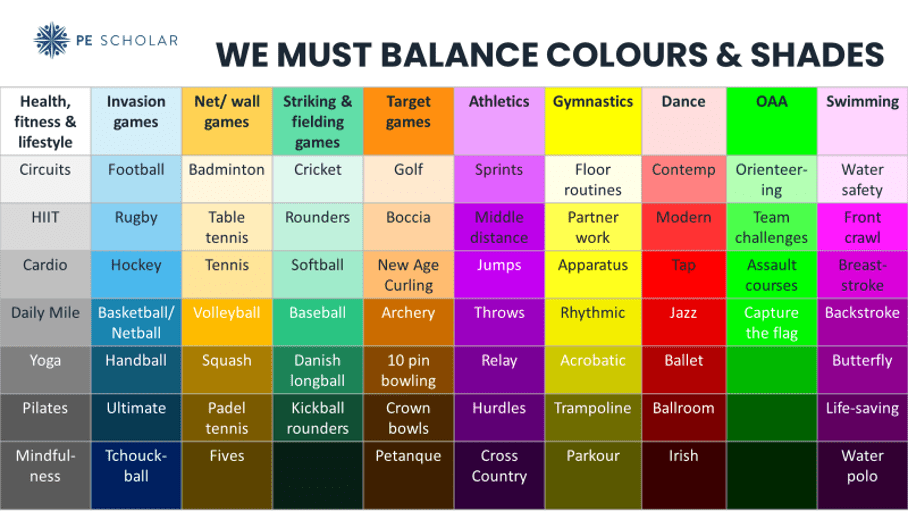
Typical realisations are that 70% or more of the experiences afforded to students during their PE time in school comes from the blue column, lots of shades of invasion games. Who do these suit? Who gains the most from them? Who is hungry for more of them?
The National Curriculum and PE Activities
Since 2013 the PE national curriculum in England no longer makes specific reference to these categories, yet nearly a decade later and these are still the categories we consider in pursuit of a broad and balanced curriculum. And we are not alone in England thinking in that way. I recently got sight of the amazing MoveWell resources developed for use in PE and Youth Sport in New Zealand – take a look here and you will find some great ides for developing more generic skills rather than child sized versions of the familiar adult sports of football, netball, rugby etc … but you will still find the all too familiar categories of invasion, net/ wall, striking and fielding and target games.
What does the research tell us?
Armed with lots of thoughts and questions related to why we use these classifications, I was really pleased to hear Dr Justin O’Connor sharing his recent research on ‘rethinking the classification of games and sports in physical education the Playing with Research in Health & Physical Education podcast back in June. I highly recommend listening to this episode here and reading the paper he published in March here. In it he argues that it is high time we reconsider the aforementioned and dominant classification framework due to shifts in patterns of sport participation. “The paper also argues for a broader conceptualisation of tactics, with social, environmental and affective dimensions a focal point for a revised, contemporary classification framework” (p2). It takes us on a historical tour to discover:
- net, batting and running game categories proposed by Maudon and Redfern in 1969 and with it “a ‘new approach’ to teaching games that marked a move from a focus on skill development through drill execution towards an educative focus on key features that sit across a group of ‘common’ games” (p4)
- invasion, net/ wall, striking/ run scoring and target game taxonomy by Almond in 1982
- territorial, target, court and field game categories proposed by Ellis in 1983
- hierarchical classification based upon tactical complexity by Méndez Giménez, A., Fernández Río, F. J., & Casey, A. in 2012
On page 10 O’Connor provides a very helpful table exploring classifications and examples of tacticial questions to prompt outcomes that @ImSporticus has summarised in the following table in his recent blog ‘rethinking a broad and balanced PE curriculum‘. I would also encourage you to read that blog, as ever, it was published promptly with great reflections whilst my thoughts on the matter have sat in draft until now.
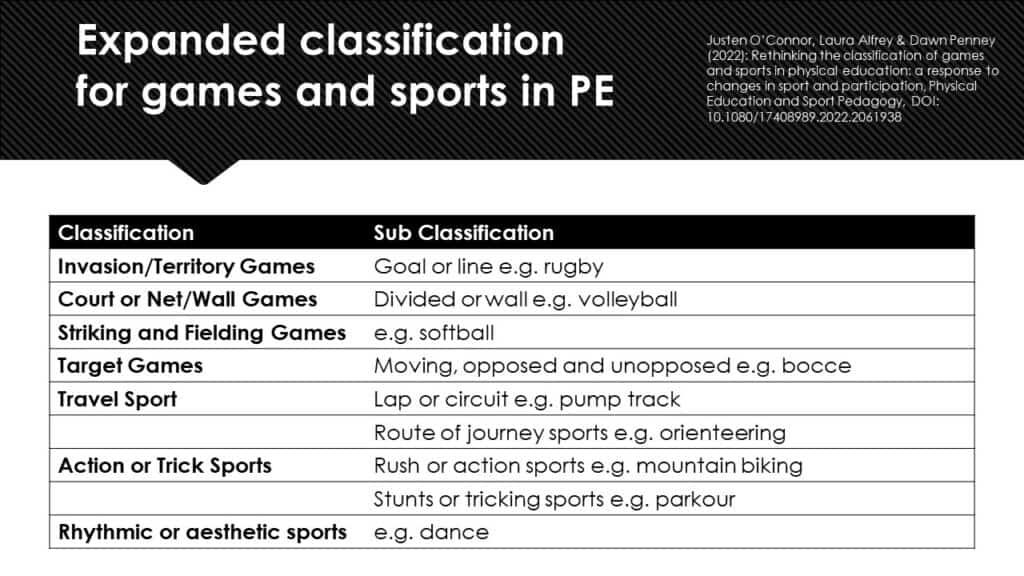
What is the way forward?
The examination system normally lags curriculum reform quite considerably. However, the GCSE and A Level PE syllabus has already moved away from that language in favour of two simple categories – team or individual activities. Take a look at the activity list here if you are not already familiar with this. Is that any better?
Perhaps this model looking at different ‘forms of movement’ proposed by our own Dr Liz Durden Myers along with Nigel Green and Margaret Whitehead in 2018 offers us a better alternative?
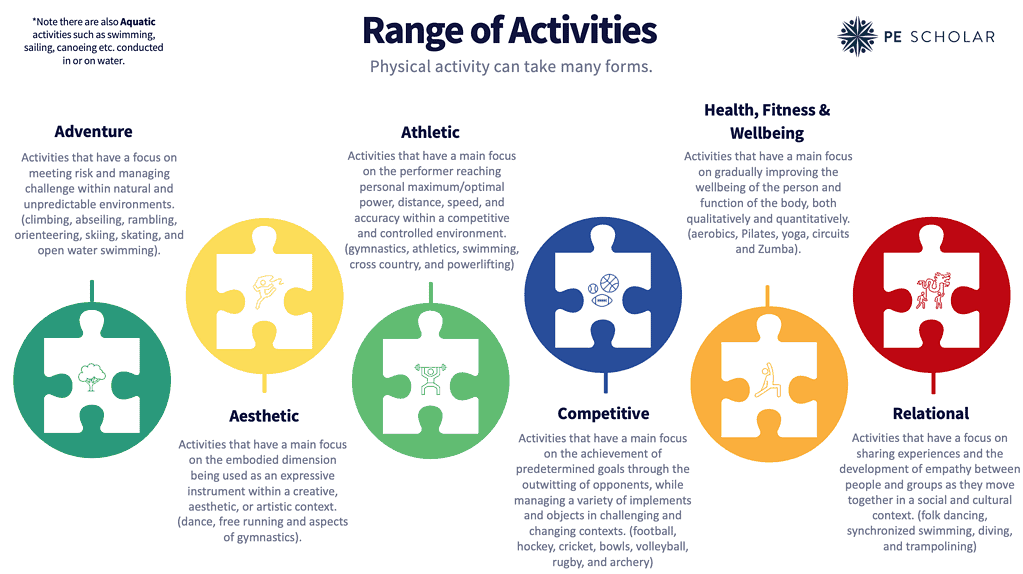
Finally, my personal view is that we need to consider far more than just the activities we use as vehicles for learning when building a broad and balanced offer in PE. For me, this is about considering a rich mix of appropriate activities, approaches and assessment that are matched to the needs and motivations of different groups of learners. It is not just about providing more and different sports in the blind hope that will hit the spot for all learners.
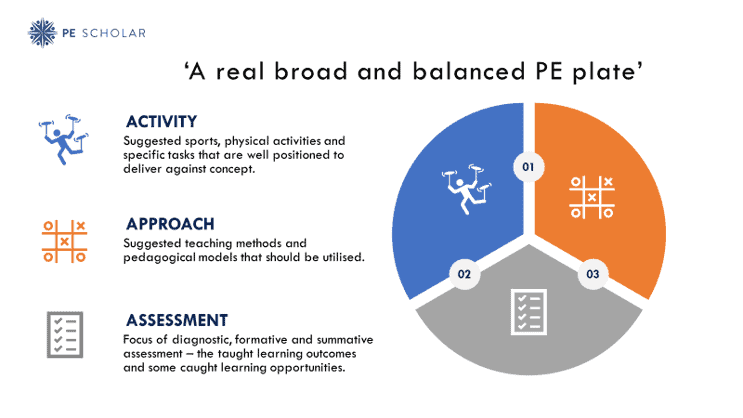
Enhancing your PE Offer
If you found this post useful or want to find out more we highly recommend taking our Awesome PE in 5 Ways Course. More information can be found here. We also recommend our blog on Nurturing Students to Flourish in PE.


[…] PEScholar – PE Activities: Rethinking How We Classify Sports and Physical Activities […]